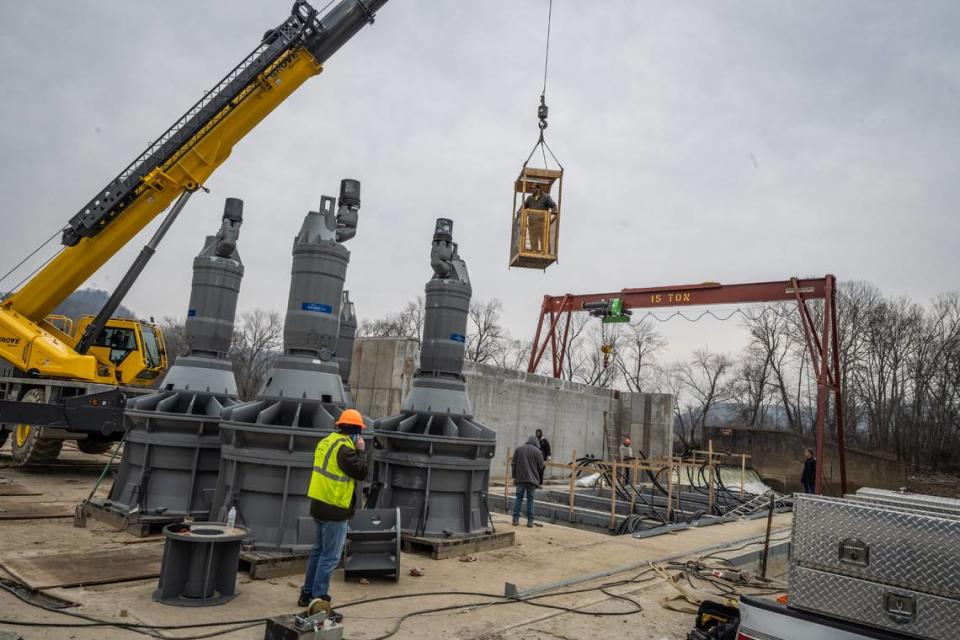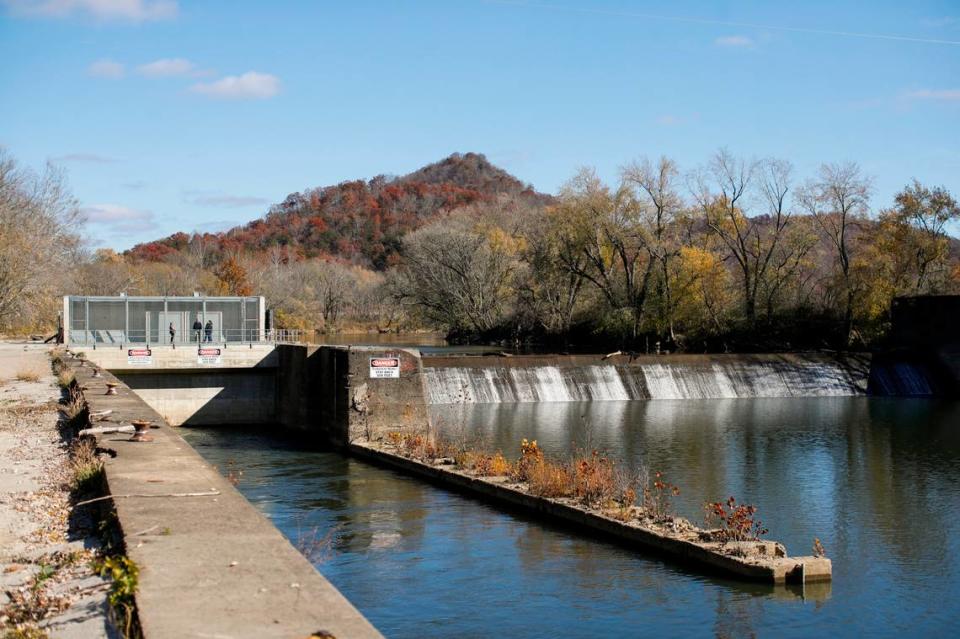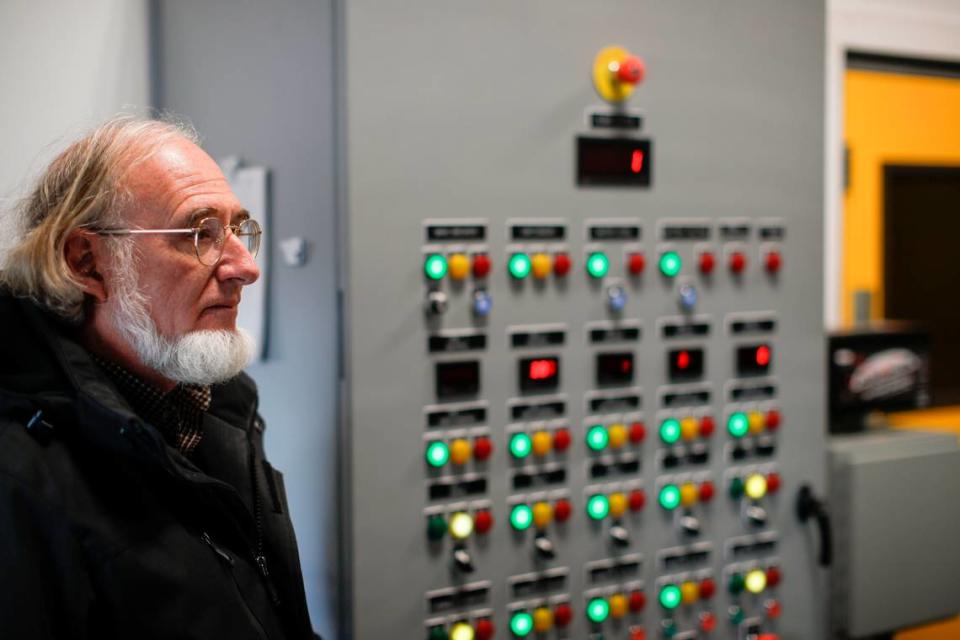‘Good in many ways.’ Berea is first college in U.S. to finish a hydropower project
There are a lot of firsts at a new hydroelectric generating station on the Kentucky River in Estill County.
It’s the first hydroelectric project in the nation completed by a college, for example.
Berea College owns the project with a company called Appalachian Hydro Associates, which was the general contractor on construction and operates the plant.
It’s also the first new small hydroelectric project in the state in more than 90 years, the first to use submersible turbine-generators, and the first new hydroelectric plant in the nation to employ variable speed turbine-generators, a technology borrowed from wind turbines that allows them to operate more efficiently.
“We’ve got a lot of new, innovative things going on here,” said David Brown Kinloch, president of Appalachian Hydro Associates, which has worked for years to develop hydroelectric projects on the Kentucky River.
The plant is called the Matilda Hamilton Fee Hydroelectric Station, named for the woman who with her husband, Rev. John Fee, founded Berea in 1855 as the first interracial and coeducational college in the South.
Brown Kinloch’s company built the plant in the lock chamber of Lock and Dam 12, near Ravenna, which had been abandoned since the early 1990s.
Contractors poured 3,000 cubic yards of concrete — more than 600,000 gallons — into the 52-foot-wide lock chamber to create stations for five specially-designed turbine-generators turned by the water.

All five units don’t generate all the time because of fluctuations in the river level, but the plant will produce enough electricity on average to power 1,200 homes, Brown Kinloch said.
The plant will offset half of the electricity Berea uses, said Lyle Roelofs, who has been president of the college since 2012.
Other universities are working on hydroelectric projects, including Notre Dame, but Berea was the first to finish one.
Roelofs, a physicist by training, said one key attraction of the project was the ability to cancel a big chunk of the college’s contribution to carbon emissions from electricity produced by burning coal.
Roelofs said the project fits with one of Berea’s governing commitments which hearkens back to the low-impact lifestyle common in Appalachia when Berea was founded. In the 21st Century, the college thinks of it as a commitment to sustainability, Roelofs said.
“Now we are trying to have a minimal impact on the climate and the environment that everyone shares,” Roelofs said.
The project ultimately is projected to be a money-maker for the college, with a long-term return on investment of more than 9 percent.
Tax credits the college sold mean the ultimate cost of the project to Berea will be less than $3 million, Roelofs said.
Berea sells the electricity from the plant to Jackson Energy Cooperative at a discount, which means revenue for the college and cheaper electricity for the utility to distribute to customers.
Jackson Energy serves about 51,000 homes and businesses. The hydropower project would not have been possible without the utility taking part, Brown Kinloch said.
The generating facility is designed for 50 years of life, but Roelofs said he thinks it will last considerably longer.
In addition to providing money for the college and offsetting its carbon footprint, the hydro project will provide educational opportunities for students, Roelofs said.
“This project is good in so many ways,” he said.
The project includes a covered pavilion with picnic tables, a portage people can use to carry canoes and kayaks around the lock and dam, and an area where people can park to go fishing.
Estill County Judge-Executive Donnie Watson said the facility will mean added tax revenue for the county and help keep down electricity rates for residents.
“It’s a big benefit to the county,” Watson said.
Lock and Dam 12, built between 1907 and 1910, was among a series of structures built on the upper Kentucky River beginning in the early 1900s so barges of coal and timber could navigate to Central Kentucky and beyond.

There are a total of 14 locks and dams on the river from Lee County, where the three forks of the Kentucky River come together, to Carroll County on the Ohio River.
By the time the uppermost locks and dams were finished, however, companies had pushed railroads into Eastern Kentucky that bypassed river transportation.
That meant many of the locks were obsolete almost as soon as they were done, Brown Kinloch said.
The U.S. Army Corps of Engineers stopped using Lock and Dam 12 in the late 1980s and there had been no commercial traffic through it in years when Brown Kinloch and his partners began working to develop it as a hydropower project, he said.
That turned out to be a 16-year project, starting with planning in 2005. It took more than seven years to get a federal license for the plant, then two years of work after that to prepare for construction, then three years to build the station.
Brown Kinloch said the project is a response to climate change, the warming of the Earth driven in part by burning fossil fuels to produce electricity, which puts heat-trapping carbon dioxide into the atmosphere.
The changes manifest differently in different places, many scientists say, such as drought in the western U.S. but more intense rainfall and flooding in other places.

Brown Kinloch said in the three years it took to build the plant, there were 23 floods on the river that reached a level that would normally be expected only one time a year, which delayed construction.
The river hit the highest level ever recorded at Ravenna in March, when high water damaged hundreds of homes and businesses in Estill, Lee, Breathitt and other counties.
That flood didn’t damage the hydroelectric station, which has more than 76 tons of metal bars reinforcing the concrete.
“It’s not going anywhere,” Brown Kinloch said.
The facility has a control building on the bank above the river, packed with electronics to monitor and operate the turbine-generators and keep track of other measures such as the level of dissolved oxygen in the water, which is important for fish.
If the oxygen level gets too low, the turbine-generators shut down until it recovers.
Water got into the basement in March, but the electronics are on the second floor, above the level of a flood that would be expected to happen only once every 1,000 years, Brown Kinloch said.
The hydroelectric plant will keep about 11,000 tons of carbon dioxide from going into the atmosphere each year.
“Just the fact that we’re generating the equivalent of half the power we use on campus without burning a lick of coal is the biggest plus in all of this,” Roelofs said.

Small hydropower projects could have an important role to play in generating electricity to deal with climate change, Brown Kinloch said.
There are 75,000 dams in the U.S., but only about 2,600 are fitted to produce electricity. Those are on the bigger dams, meaning getting more electricity from hydropower will require putting turbines at smaller dams, he said.
The Estill County project could serve as a model for how to do that, he said.
“If we want that clean hydropower we’re gonna have to go so smaller sites like this,” Brown Kinloch said.
Appalachian Hydro Associates finished the plant in late May.
It has worked well since, though logs and trash floating down have been a sticking point, Roelofs said.
The plant has a steel gate designed to block debris from the intake tubes leading to the turbine-generators. Then, a trash rake pulls the debris up into a trough where water flushes the trash back into the river, bypassing the turbines.
It has required more hand work, such as sawing up logs, to clear the debris, Roelofs said.
Roelofs said he’s confident the engineers will figure out a solution. In addition, Berea students are working on an artificial intelligence system to pull plastic milk jugs out of the trash so they don’t go down the river, he said.
In October, Berea’s trustees approved building a second hydroelectric plant at Lock and Dam 14 in Lee County.
The schedule calls for construction to begin next month and for the plant to go online in May 2024, Brown Kinloch said.
The two plants together will offset all of Berea’s carbon footprint from electricity.
Roelofs said Berea is trying to be an example of what can be achieved in sustainability projects, and that those projects are the right thing to do.
“It suggests to the whole state, I hope, that there are good opportunities out there,” he said.

